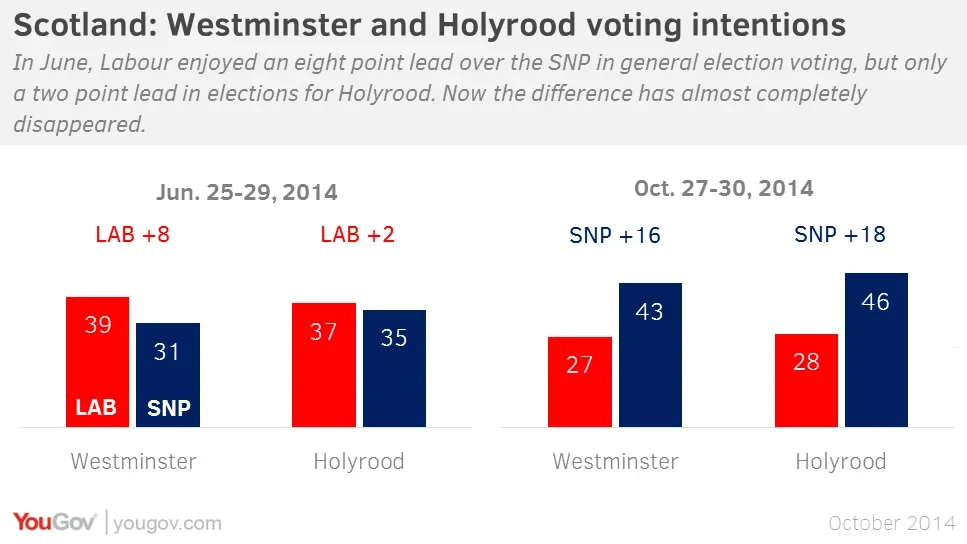What YouGov's new Scotland poll says about the rise of the SNP, the disappearance of 'red Nats', and the potential for a new 'normal' in Scottish politics
Labour faces a double whammy in Scotland. It has lost support generally; and it can no longer count on being saved at a general election by ‘red Nats’ – people who back the SNP in Holyrood elections but stay loyal to Labour when choosing an MP to send to Westminster. These explain why YouGov’s latest poll for The Times suggests the SNP is on course for the first time to have a majority of Scottish MPs at Westminster next May.
In the 2010 general election, twice as many people voted Labour as SNP. A year later, in the elections to Holyrood, the SNP comfortably defeated Labour. Whenever YouGov asked Scots about the two kinds of elections, we found a large difference. Many voters wanted SNP to govern Scotland, but Labour to govern Britain.
That difference continued for some time after the last Holyrood elections. There were signs that it was declining earlier this year. In June, Labour enjoyed an eight point lead over the SNP in general election voting, but only a two point lead in elections for Holyrood.
Now the difference has almost completely disappeared. Labour has been swept aside by an SNP surge on both fronts. The SNP leads Labour by 16 points in general election voting (a massive 19 per cent swing since 2010), and by 18 points in Holyrood voting (a far more modest two per cent swing since 2011).

The disappearance of the ‘red Nats’ means that Labour faces a near wipe out next May, unless it can revive its fortunes. If we apply the Scotland-wide shifts to each constituency, the SNP would jump from six seats to 47 while Labour would slump from 41 to just ten. The Conservatives would retain their single seat, while the Liberal Democrats would lose ten of their 11 seats, keeping only Orkney and Shetland.
On these figures, Labour would be unlikely to be the largest party in the next Parliament. However, even the Conservatives come out comfortably ahead there may not be enough Lib Dem MPs to combine with them to provide a working majority in the new House of Commons. They would need a deal – even if not a full coalition – with the SNP.
Is an SNP surge on this scale really likely? We are in uncharted territory, and any prediction now can be little more than a guess. However, there have been moments in history when the Lib Dems have suddenly jumped in the polls – after a spectacular by-election win, or following the first TV debate in 2010 when Cleggmania briefly gripped the nation – only to subside as politics returned to normal. Perhaps Labour’s Scottish MPs won’t be trounced next May after all.
However, an SNP optimist could offer three responses. First, the referendum and its aftermath have changed everything. The old ‘normal’ has gone for ever; it won’t return.
Second, it can now offer something that has eluded it in the past: a compelling reason to support the party in a general election when it is not seeking to run Britain. Next May it can tell Scottish voters: ‘vote SNP to hold London’s feet to the fire and ensure it delivers the extra powers the party leaders have promised’.
Third, our Holyrood voting figures, with their small swing since 2011, suggest that our figures for SNP support are not a bubble. In fact the SNP’s own Holyrood vote share now, 46 per cent, is much the same as the 45 per cent it secured in 2011.
Labour must face the hard truth that it is suffering not a brief setback but a more fundamental loss of respect. Just 31 per cent of Scots who voted Labour in 2010 now think the party ‘represents the views and interests of Scotland today’ very or fairly well. Fully 59 per cent think the party does this job very or fairly badly. Those are truly terrible figures. If Labour can’t reverse them by next May, its prospects north of the border are bleak indeed.
An edited version of this commentary appears in today’s Times.
PA image





